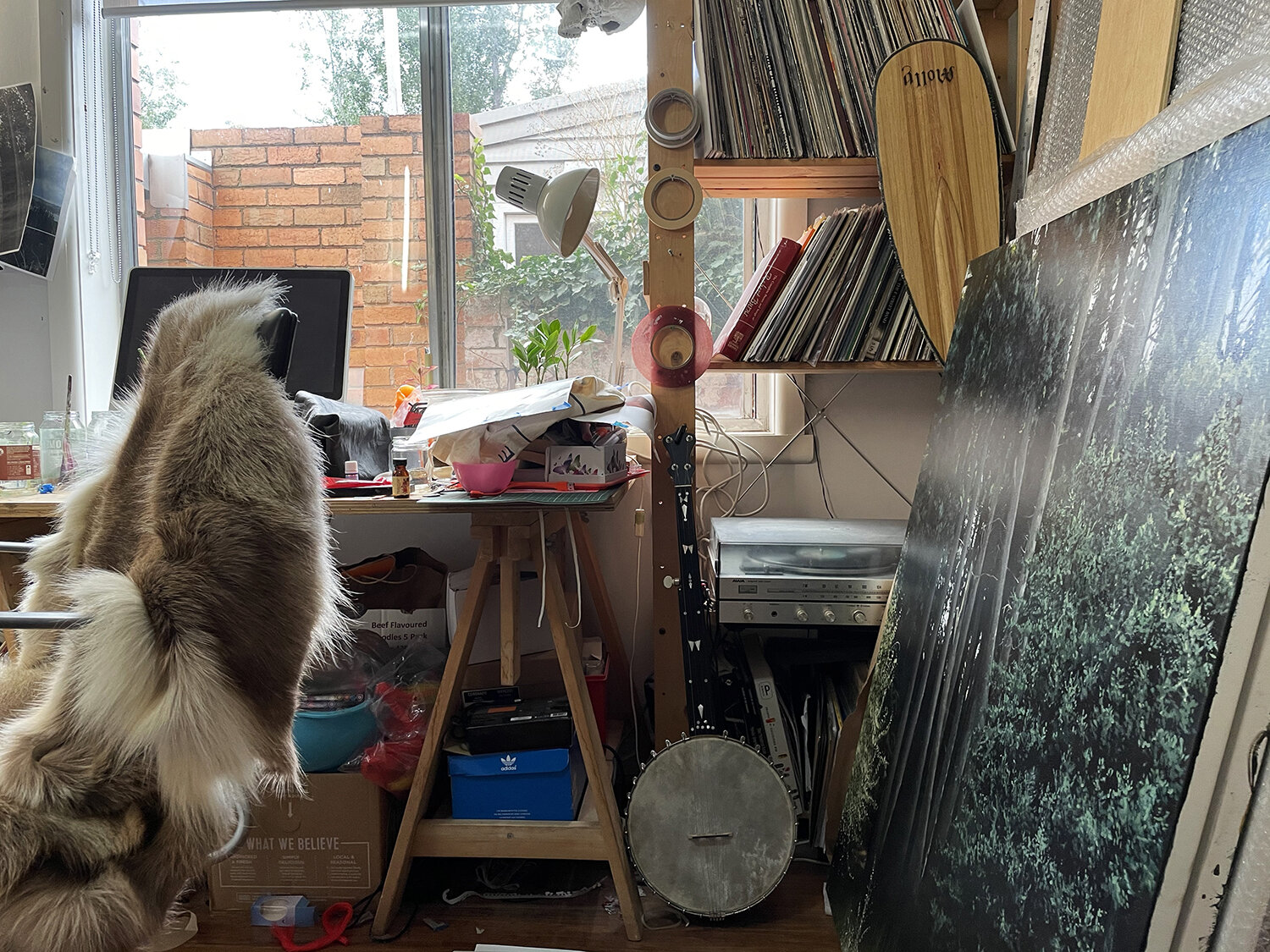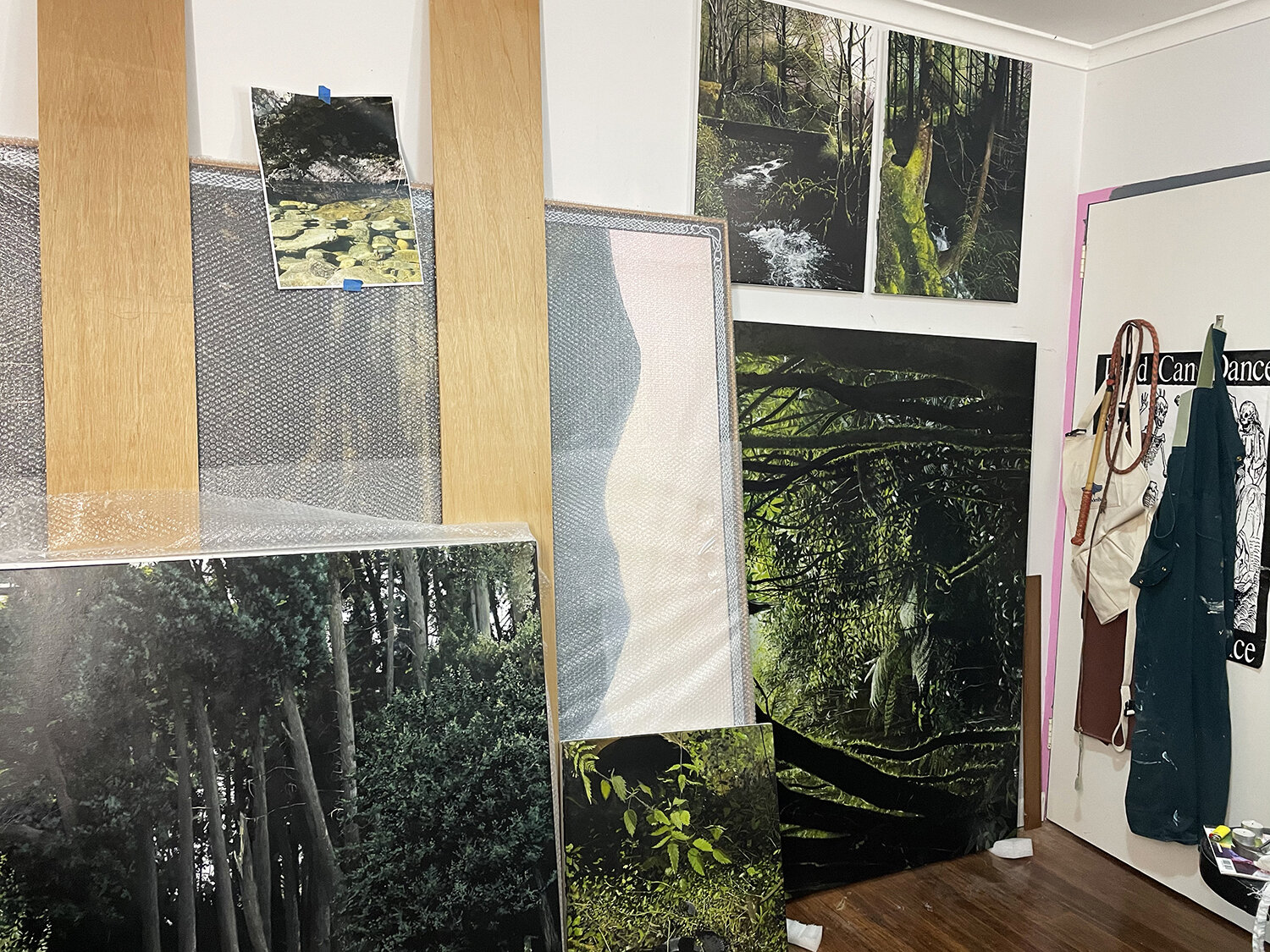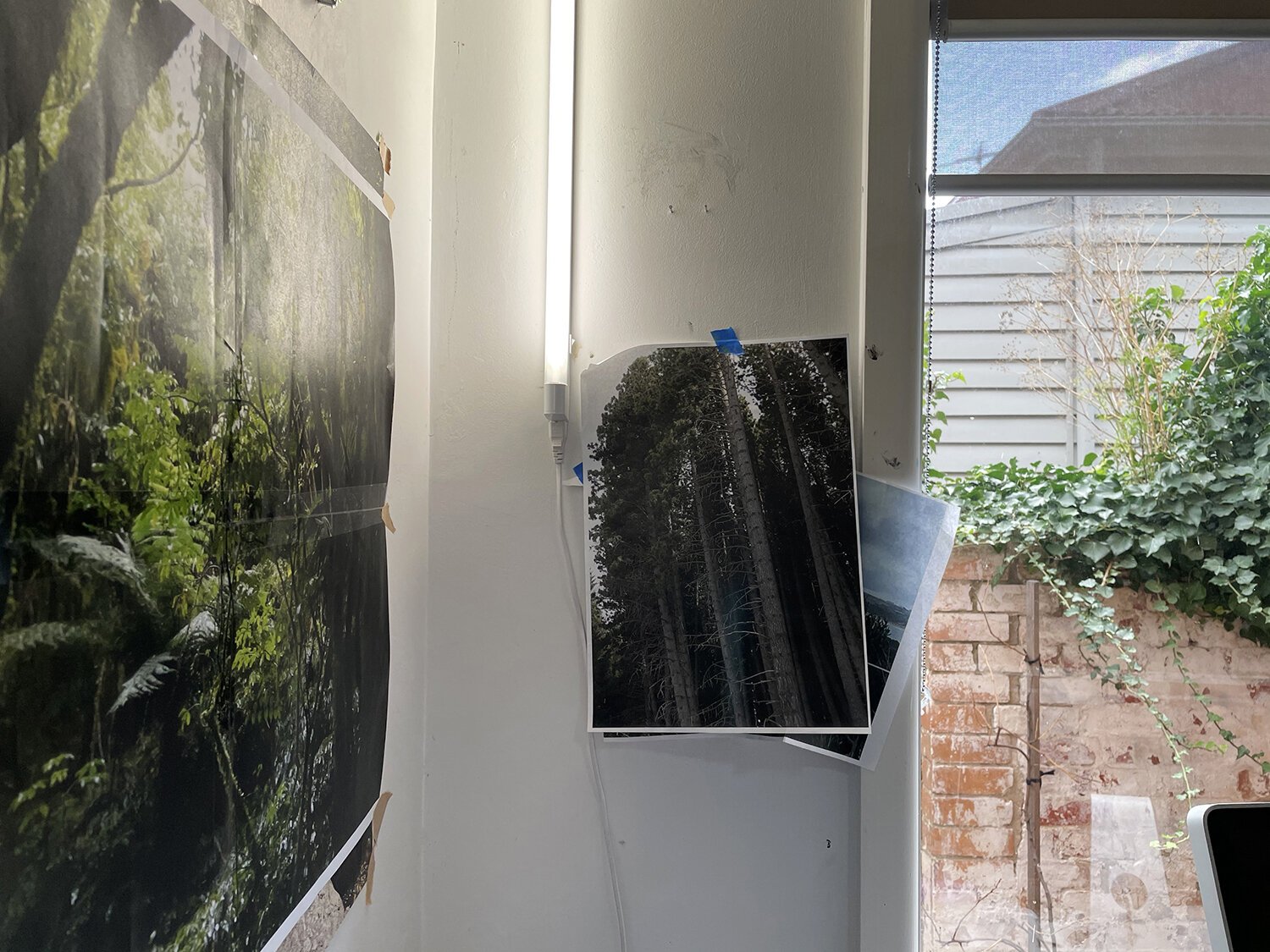In the studio
with GRANT NIMMO
April 2021
DS: Could you tell us about your studio and working environment? Does this influence the work you are making?
GN: My studio is at home in Coburg where I live in a flat with my partner Molly and our son Oban. The home studio has been very convenient, but it doesn’t really influence the content of my paintings.
It does influence the planning of works, and the materials I use. The studio is very small so larger works are fewer and far between, as I need to consider space a lot. I prefer working larger, so I dream of a bigger studio with plenty of room for very large canvases.
Grant Nimmo, A heavy way, 2020, oil on linen, 112 x 97 cm, 115 x 100 cm framed, photograph: Tim Gresham
DS: How did the pandemic affect you and your work?
GN: With my studio being at home it didn’t affect me too much, as I was able to work through lockdowns. I was also working less in my day job and without the burden of travelling to and from work my studio time definitely benefited. Though I had plans to travel for resource material for an upcoming show in NZ which I had to scrap (the trip not the show).
When things were getting really heavy it felt strange to be painting forests, it sort of seemed superfluous at a time of illness, mass unemployment and death. Sometimes it felt a bit silly or like painting would have no future anyway. But painting tends to calm me down or make me feel a sense of reassurance, so I saw that as a positive and kept working hard. Sometimes it made me feel like the quartet on the Titanic movie from the ’90s, playing their instruments as the ship sinks.
DS: Your son is nearly two. How have you managed your artwork alongside parenthood, particularly during lockdown, and has it altered your relationship to your practice?
GN: Having Oban has changed the way I work; I think it’s made me a lot more disciplined and committed to painting. It’s definitely been hard to balance parenting, a full-time day job and studio work, but again I think I’ve really benefitted from having the studio at home. I’ve become pretty strict with my practice and I usually make up studio time when Oban’s gone to sleep. I’ve been working in the studio in shorter stints and at different hours, mostly later at night or early in the morning. Some days I wake at 4:30am and paint for a few hours before going to work then head back in there after he’s gone back to bed for the day.
I no longer have long hours of uninterrupted studio time, but it doesn’t really bother me, I like working in shorter but more productive stints, especially having slept a lot less over the last couple years. It’s hard to stand up for eight hours painting when you’re extremely sleep deprived!
Oban is very curious about the studio and sometimes if he’s around when I’m working, he likes to come in and check out what I’m doing and help out or point at things. He has a little box of paint there that I sometimes get out so he can paint something too and he loves that.
DS: Could you tell us about your painting process?
GN: A painting usually starts with identifying an image that I want to paint. I only use my own photos as reference so I guess you could even say the process for a work starts prior to that, with a walk or a hike.
I print off reference pics but after the painting’s about 70% complete I usually roll them up and let them develop for the remainder without any reference. I think it’s a way of avoiding letting it get too polished or photo realistic. The paintings are pretty thinly layered - sometimes they take weeks and others take months.
Painting has always been a pretty intuitive and self-taught process for me, not a lot of pre-planning, no pre-mixing paints or developmental sketches or studies or anything like that. A couple of years ago, a late friend invited me to visit the late Fred Williams’ studio with him. I was amazed at how much had been archived, and how much planning he had put into larger works. Afterwards I tried to be more patient and premeditated with my output, but I think I get so excited by beginning new work that I can’t help myself from just rushing straight in.
DS: What materials do you use?
I try to use quality but low toxic materials. Langridge have some low toxic mediums and solvents that I always use. In terms of paints, I’m lucky that my colour palette is limited to only five or so colours so I buy the expensive stuff, as I don’t go through much, usually I can’t go past Michael Harding paints.
In the past I’d painted on gesso board a lot, but I’ve moved completely onto linen now, as I found the smaller scale and smoothness of gesso board was somehow making me really finicky with the works. I decided after my last show in NZ that I wanted to let the paintings loosen up somewhat and get a bit rougher...
DS: Can you tell us about the paintings in The soldiers of art?
GN: These paintings were all made after our son was born in May 2019 and finished by the end of 2020. They are all from Argyll in Scotland, and the entire show documents a day’s walk, starting in a damp glen then climbing up into a higher pine forest later in the afternoon, and then back down the other side of the glen. I only realised this after seeing them all up together in the gallery, but I feel like it’s the most united body of paintings I’ve presented because of that. I like the way the light changes and fades throughout the works as the sun comes in and out before it sets for the day.
Grant Nimmo, The soldiers of art, 2021, installation view, photo: Tim Gresham
DS: There is a definite darker aesthetic to your work and the places you have chosen to paint. What landscapes are you drawn to?
GN: I guess the darkness is just a reflection of what culture I consume. The types of music or films I like are usually a bit on the darker side or even a bit bleak.
I am definitely drawn to the Northern Hemisphere in terms of a setting - I like to paint thick pine forests. Hopefully soon we can travel again, I’d love to visit Ireland, Scandinavia and Canada.
Grant Nimmo, 2019, Soldier of art, oil on linen, 158 x 132 cm, 161 x 135.5 cm framed, photograph: Tim Gresham
DS: There are elements of folklore, symbolism, and heraldry throughout your practice over the years. Could you tell us about this? Your last exhibition here, The Goat Herder’s Cry, melded together actual and imagined folklore, motifs and symbolism drawn from Victorian history, and many of your works incorporate painted decorative borders of Celtic knots, ropes and sticks.
GN: I’ve always had an interest in folklore and it has sometimes come through in my work abstractly and graphically, especially with The Goat Herder’s Cry show I had with you in 2016. In that show, I wanted to explore these interests in the foreground by building a show using motifs and symbols developed around my own imagined folklore.
I think with these recent paintings being of Scotland, it was a way for me to confidently continue to explore and weave a little bit of that interest, and more specifically my interest in Celtic lore into the landscape works in the form of the knot motif borders.
The idea of the knot design I’d been exploring for a while and there was a work from The Goat Herders Cry that had a plaited hair border, which is where this element began to come through into my paintings.
It’s sort of refreshing to change the approach to painting a bit as well. The landscape portion of the work comes pretty intuitively so to add a graphic element into that forces me to stop and think a bit more. It’s a harder process for me to paint something in that way, it doesn’t come naturally so after I’ve finished, I feel more rewarded as I’ve challenged myself a bit, as it’s actually really painstaking to paint them.
DS: You have an exhibition coming up later in the year in New Zealand, could you tell us about the works you are making for that exhibition?
GN: Yes, that’s going to be my second solo in Auckland with Ivan Anthony.
I think with landscape painting I started making landscape works because I was interested in a certain atmosphere rather than coming at it from an interest in a place, but the plan for this show was to go over to NZ and do some walking and then come home and paint the country there. Unfortunately, COVID border closures have ended that plan, so I’ve had to figure out an alternative.
I do have a good archive of images that I usually work from so I’ve had to go back into old hard drives looking for old pics to paint, trying to find some that will work together cohesively as a body of work. The places range from Patagonia to Japan, so the colours and foliage differ drastically, but I think they are drawing together through something else, hopefully.
DS: Over the years, your work has moved towards pure landscape. Could you tell us about this trajectory, and where you think your work will go in future?
GN: I actually started with landscape painting then moved away from it for a time. The first oil painting I ever made was looking at Mount Dandenong from the suburb Kilsyth where I grew up. The first show I had was with Evan Hughes in 2009 and it was a landscape painting show, but then after that show I started trying to push it back a bit, making it more of a backdrop than the main feature. I was younger and I think I was influenced by artists like Neo Rauch and Peter Doig. I liked the way their work was landscape painting that had been introduced to a narrative, so I set about doing something similar. I also wanted to explore other things that I couldn’t figure how to fit in with landscape, so I drifted further away from it.
In 2016, (after my last show with you Daine) I went on a 4-day hike to Frenchman’s Cap in the Franklin-Gordon Rivers Park in South West Tasmania. When I came back, I didn’t have any shows planned and hadn’t been painting much, so I made a painting from the walk. I let that sit for a while and after the trip to Scotland (the trip the paintings in this show were from) I decided that I just needed to paint landscapes. I wanted to try to spend the rest of my life getting better at it. I think in my own weird way I decided to drop out a bit from where contemporary art was going, or where I was going with it, and just spend time being patient and perfecting something seen largely as pretty daggy or irrelevant.
DS: Who are your favourite artists, and are they an influence on your work?
I’m not really sure I have a favourite artist or artists. There are paintings that I like, At the Edge of the forest by Hans Emmenegger, Constable’s Study of the Trunk of an Elm Tree. I also like a few of Ivan Shiskins's pictures, Russian landscape painters are nuts.
A brief list, what are you currently:
Reading
I don’t read a lot, probably only a couple of books a year. The last book I read was The Rise and Fall of Gunns, about logging in Tasmania, the history of corruption and the birth of the environmental movement there.
Watching
I just binged 6 seasons of Alone on Viceland.
Listening
I’ve been listening a lot to an American singer Sharron Kruass’s album Pilgrim Chants and Pastoral Trails.
Enjoying
Just being at home with my family, going for walks down at the Merri creek. Been nice to be able to get out of the city a bit too.














